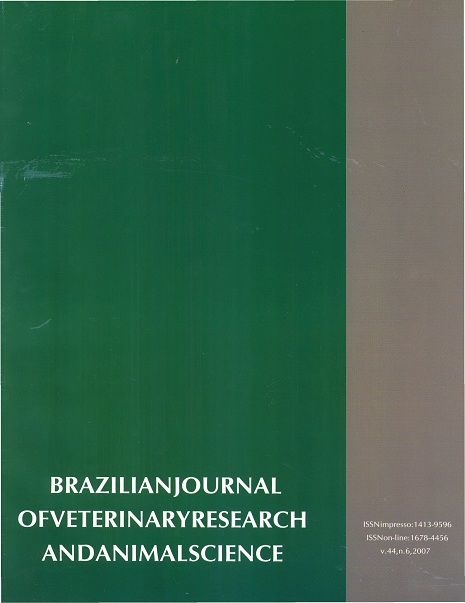Ovarian follicular dynamic and embryo production seasonality in Guzerá heifers breed
DOI:
https://doi.org/10.11606/issn.1678-4456.bjvras.2007.26607Keywords:
Follicular dynamic, Thermal stress, Guzerá, Embryos, SuperovulationAbstract
The objective was to verify the effects of seasonality on ovarian follicular dynamic and evaluate the influence of heat stress on early embrionic development in Guzerá heifers. Six animals were sincronized and the estrus day was considered D0. Follicular dynamic was followed by two consecutive estrous cycles, at times 1 (summer) and 2 (winter), using an ultrasonographic Scanner 200 Vet (Pie Medical). After nine days of the end of second estrous cycle, all the animals were submitted to superovulatory treatment, with duration of four days. The animals were artificially inseminated, 12 to 24 hours after estrus detection. Embryo collection was realized seven days after the first insemination. There was seasonal effect on the number of follicular waves, with a greater prevalence of cycles with one wave in the summer. The intervals between estrus and ovulations showed a greater duration in the summer. There was a significant effect of time on the duration of the ovulatory follicle growth that was longer in the summer. The follicular growth rate was smaller in the summer. Rectum temperature oscillated between times, become evident the influence (P < 0.05) of season on the internal body temperature. The THI observed on summer was 94 and winter was 86, these values suggest the animal stress condition. The number of viable structures was higher in winter, suggesting the effects on time 2 on fertilization of the oocytes. Progesterone concentrations did not have seasonal effect. Thermal stress alterations on follicular dynamic, such do reduced follicular growth rate and increase on duration of follicular growth. Might prejudice the quality of oocyte and affect the subsequent corpus luteum functionality.Downloads
Download data is not yet available.
Downloads
Published
2007-12-01
Issue
Section
UNDEFINIED
License
The journal content is authorized under the Creative Commons BY-NC-SA license (summary of the license: https://
How to Cite
1.
Gama Filho RV da, Fonseca FA, Ueno VG, Fontes R da S, Quirino CR, Ramos JLG. Ovarian follicular dynamic and embryo production seasonality in Guzerá heifers breed. Braz. J. Vet. Res. Anim. Sci. [Internet]. 2007 Dec. 1 [cited 2024 Apr. 16];44(6):422-7. Available from: https://www.revistas.usp.br/bjvras/article/view/26607





